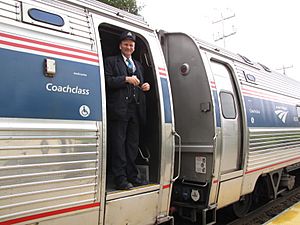Conductor (rail) facts for kids

A conductor (North American English) or guard (Commonwealth English) is a train crew member responsible for operational and safety duties that do not involve actual operation of the train/locomotive. The conductor title is most common in North American railway operations, but the role is common worldwide under various job titles. In Commonwealth English, a conductor is also known as guard or train manager.
The responsibilities of a conductor or guard typically include the following:
- Ensuring the train follows applicable safety rules and practices
- Making sure the train stays on schedule starting from the stations
- Opening and closing of power operated doors
- The selling, buying, and checking of tickets, and other customer service duties
- Ensuring that any cars and cargo are picked up and dropped off properly
- Completing en-route paperwork
- Directing the train's movement while operating in reverse
- Coupling or uncoupling cars
- Assisting with setting out or picking up of rolling stock
Some rapid transit systems employ conductors to make announcements and open and close doors—as opposed to a train operator performing those duties. The conductor often stays in the center of the train where they can best view the platform. While advances in automation allow most transit systems to use one person train operation (OPTO), a few, such as the New York City Subway, Toronto Transit Commission and Sydney Trains continue to employ conductors.
Conductor is also a crew member in some bus, trolleybus or tram operations.
Commuter and freight trains in North America
In North America, the Conductor manages a freight, passenger, or other type of train, and directly supervises the train crew, which can include a brakeman, flagman, ticket collector, assistant conductor, and on board service personnel, and is responsible for the movement of the train. The engineer (driver) takes direction from the Conductor. The portman (station master), and additional engine crew members (fireman, pilot engineer) share responsibility for safe and efficient train operation and adherence to railway rules and procedures. On some railroads, union contracts specify that a conductor must progress to engineer.
Other duties carried out by the conductor include:
- Jointly coordinate with the engineer and dispatcher the train's movement authority, and verifying this authority is not exceeded
- Communicate and coordinate with other parties—yardmasters, trainmasters, dispatchers, on board service personnel, etc.
- Be alert to wayside signals, switch position, and other conditions that affect safe train movement
- Mechanically inspect rolling stock
- Assist the engineer in testing the train's air brakes
- Signal the engineer when to start or stop moving
- Keep a log of the journey
- Check tickets and collect fares on passenger trains
- Keep records of consignment notes and waybills
- Direct, coordinate, and usually manually perform, shunting or switching
Passenger trains may employ one or more brakemen/assistant conductors who assist the conductor and engineer in the safe and prompt movement of the train, to share the workload, and accept delegated responsibility. If a train crew's route, or tour of duty, exceeds a single shift, or conflicts with a legal or contractual limit on the number of work hours, more than one crew may be assigned, each with its own brakeman/assistant conductor. Onboard service crew members on passenger trains normally remain on duty for the entire run, including assigned meal and sleep breaks.
Since nearly the beginning of railroading in North America, the conductor on freight trains rode aboard a caboose, along with the rear flagman and the rear brakeman, and performed duties from there. Advances in technology and pressure to reduce operating costs made cabooses redundant, and in most cases they have been eliminated. This relocated the conductor from the rear of the train to the locomotive (or locomotives) at the head of the train. In most cases, these same conditions gradually eliminated members of the train crew, such as the head brakemen, flagmen, and others.
Most freight trains on most railroads today have a crew of two: one engineer and one conductor. Railroad companies continue to press for reduced operating and labor costs and this threatens to eliminate second men. Railroads rationalize that since the engineer is already qualified as a conductor man, he can easily assume the duties of a conductor. In fact, on most railroads, engineers begin as brakemen, then become conductors, and finally engineers. Some railroads already implement such a strategy, notably the Montana Rail Link, and operate with an engineer, and a conductor. However, most railroads are contractually obligated to employ a brakeman/assistant conductor in addition to the engineer, via crew consist agreements negotiated with the major rail unions, primarily the United Transportation Union (UTU). Therefore, eliminating the conductor's position would require that the railroads and unions negotiate a new agreement. If the railroads were successful, conductors already trained and certified as engineers would theoretically be able to work as engineers. Those that have not yet progressed to engineer would have to be trained as engineers as positions became available. Others would have to accept other positions or possibly lose their jobs. The primary union for engineers, the Brotherhood of Locomotive Engineers does not support this movement, claiming that requiring its members to operate trains alone would be unsafe.
Images for kids
-
Streetcar conductor 1919 in Flint, Michigan






